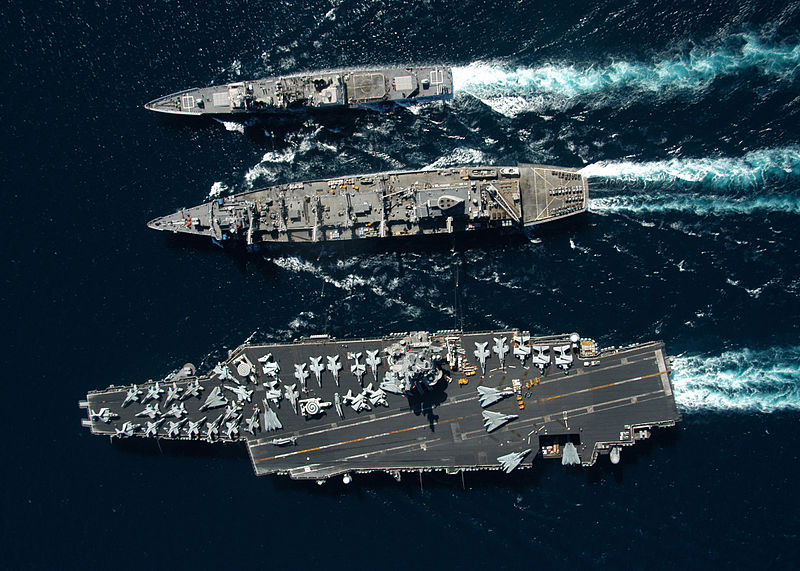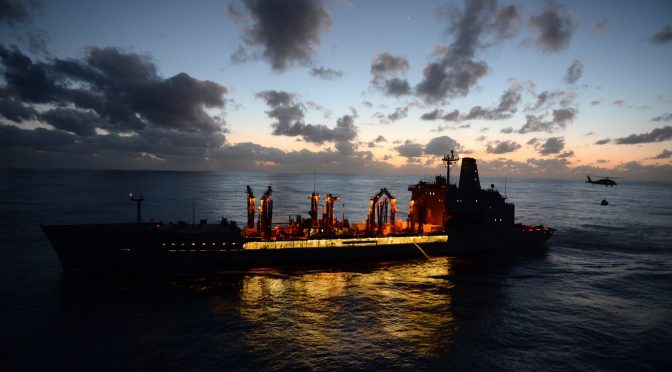By Chris O’Connor
The Future Capital Ship
During a recent CIMSEC topic week, the idea of the “Future Capital Ship” was discussed. This hypothetical asset was depicted several different ways that week. Transplanting the idea of the twentieth century battleship or aircraft carrier to the near future, this conceptual combatant could be bristling with railguns and directed energy weapons, in lieu of an “all big gun” dreadnaught’s armament. It could also be the mothership to many cross-domain unmanned systems, an update to the aircraft carrier archetype. Some viewed “capital ships” of the future as swarms of unmanned systems operating autonomously, a complete disruption in naval warfare akin to the first dreadnaught – eliminating the need for a manned vessel entirely.
Taking a different route, the organizational investment that was put into the capital ships of the past could be applied in a way that transcends the idea of physical warfighting platforms. The CNO Strategic Studies Group 35 used that thought experiment to point out that the Navy of the future should treat the “Network of Humans and Machines” as the future capital ship. The argument was also well-made that investments in information warfare and cyber capabilities should be at the forefront, even to the extent that the U.S. Navy will eventually evolve into a cyber force with a maritime component.
These concepts are all deserving of consideration, and the future Navy will most likely be a combination of many of them, but the major foundation of naval power is usually an afterthought. The dominant Navy of the future will be the one with the most robust and adaptable logistics support structure needed to succeed in the future high-end fight as well as maintain command of the seas in peacetime through sustained global presence.
Death of a Salesman
Aggressive recapitalization of the Combat Logistics Force (CLF) is needed because the Navy’s current logistics force structure is unprepared to support a distributed fleet in a fight against a peer competitor. There are fewer than 40 hulls in the CLF, a mix of oiler (AO and AOE) and dry cargo (AKE) supply ships of differing types. It is impossible employ them all at once, so the effective number of usable hulls is in fact lower for they require upkeep like every other vessel. They are incapable of defending themselves from anything other than limited numbers of lightly-armed small boats. This leads to the unfortunate conclusion that a limited number will be available to replenish shooters in the fight – if they can survive an area denial battlespace. In a high-end fight, they will become prime targets, and providing escorts to CLF assets only takes shooters away from the fight. But given the logistically-intensive nature of naval power projection, CLF ships will take on capital-ship value in a tightly contested conflict.
The force structure of CLF ships we have today is based off of their employment in the older model of hub-and-ferry routing, centered on specific ports in overseas Areas of Responsibilities (AORs). As the Navy moves toward fighting as a distributed fleet, it creates a complex variant of the travelling salesman problem (TSP). Familiar to anyone who has taken an operations analysis business course, TSP looks for the optimization of a route that passes through a set of points once each. Cities or houses in a neighborhood are often the problem set. In a disaggregated environment, a replenishment asset must do the same (if its customers have to stay in the fight), but the difficulty is compounded by the fact that the delivery locations will be moving targets and the distances between them will stretch around threatened areas and land masses. The academic TSP problem seldom includes the possibility of the salesman getting killed and never reaching the destination. In addition, naval assets are going to be limited to external lines of communication in some future conflicts. Ships will travel farther distances than their peers in the opposing force, leading to longer transit times between shore support and afloat customers.
CONOPs and Force Structure for Distributed Naval Logistics
Distributed naval warfare needs more “salesmen,” working together as an interconnected web of logistics assets. An enlarged fleet of combat support vessels is the base of this new support schema. Practically, this is easier done than asking for more warships. As we build a larger number of warships for the future, our military shipyards are going to reach capacity, especially if they continue to build platforms using conventional methods. New replenishment ships can be acquired in a number of ways, apart from dedicating some military shipyards to building replenishment vessels (which will take away from warship building capacity), or building them in foreign countries (which is politically unfeasible). There is a surplus of offshore support vessels (OSVs) that could be purchased and put into Military Sealift Command (MSC) service, along with other commercial vessels that could be modified for CLF purposes. Modified in smaller civilian shipyards instead of military ones, they could create work that would please the constituents of a number of decision-makers on Capitol Hill. Under new CONOPs, vessels such as OSVs could be employed in shorter range replenishments to independent deployers on missions such as antipiracy and ballistic missile defense.

These additional CLF vessels will still be vulnerable, especially if kept in the current MSC construct as unarmed USNS assets. Risk of enemy attack will have to be built into the calculus of how these ships are employed. But giving them sufficient self-defense weapons and damage control resilience to survive being set upon by enemy platforms would be prohibitively expensive. A larger number of our vessels would create a targeting problem – they can service more combatants, operate from more ports, and inject uncertainty into the situational awareness of an adversary. In the current model, there are only a couple of CLF vessels operating in an AOR, and watching select ports will give plenty of indications of U.S. Navy presence.
These ships can be augmented with automation to the level that is currently employed on commercial vessels, allowing MSC to man more ships with the same number of personnel. An AKE in current MSC service has approximately 130 personnel onboard, while there are thousands of commercial vessels afloat with crews numbering less than 30. At-sea replenishment creates demands for more personnel during alongside evolutions, but this could be mitigated with updating the CONREP (connected replenishment) stations with new equipment. The receiving ship could guide the delivery ship’s systems remotely with short-range remote operation systems, supervised by a few merchantmen on the delivery ship. A fly-away crew could attend to this equipment only when needed, and not ride for long transits, or into harm’s way.
To reduce the threat profile of the manned CLF hulls, a system of smaller unmanned systems would create a web of logistical support. Cargo unmanned aerial systems (CUAS) will travel hundreds of miles point-to-point to deliver critical parts, instead of sailing entire vessels closer to get within VERTREP (vertical replenishment) range. They could carry parts for multiple customers and use aviation-capable ships as lily pads to get to others. Heavier lift CUAS could carry out VERTEP from unmanned CLF vessels to delivery ships, obviating the need for sailing alongside to transfer parts in a connected replenishment with a robotic vessel. These systems would be augmented by small unmanned surface vessels, possibly based off of the Sea Hunter Unmanned Surface Vehicle (USV), that could blend into surface traffic and make deliveries in battlespaces that are not conducive to aerial vehicles.

There are a number of solutions to support problems that will also be needed in the Navy of the future. Digital investments will be needed to improve our logistics IT structure to create a more resilient and adaptable family of systems. Taken to the farthest extent, this would lead to Vertical Expert Systems (specialized AI), predicting demand through data analytics and optimizing the use of delivery assets. Additive Manufacturing will allow parts sourcing from many more locations than are currently available. Underway ships could eventually have the ability to make complex parts for their use or for other vessels that lack the technology. Fuel production from bacteria and “grow-tainer” produce farms could bring commodity sourcing much closer to the fight. Adoption of these technologies is important, but they do not eliminate the need for support to be physically delivered to our combatants anytime in the near future.
Recognizing Priorities
The counterargument to a larger fleet of CLF hulls deserves to be heard. The Navy is looking toward a 355-ship force, and most of that plus-up number would be in warships. We want a lean Navy- with as little tooth-to-tail as possible, and the idea of buying more replenishment assets seems to be anathema to that. But the Navy must recognize it is unable to fight a long-term shooting war, especially in a disaggregated manner, with the current CLF force structure. A larger fleet of combatants only complicates this problem, especially since a majority of these shooters will be powered by liquid petroleum products that have to be brought to them.
To placate these concerns, these new vessels do not have to be single mission vessels, dedicated only to logistics. They could act as routers for line-of-sight transmissions, or even couriers of data packages between other platforms when they carry out their supply missions in a communications-restricted environment. They could seed sensors or deploy and recover unmanned systems in their transits. These missions could reduce the burden on warships and dedicated survey ships in peacetime and in war.
A Worthy Investment
A successful future U.S. Navy will be comprised of innovatively designed combatants, with arsenals of new weaponry, employing cyberwarfare and unmanned systems to an extent that we can barely conceptualize now. They will still need a capital-ship level of investment in an interconnected web of logistics assets to fight against a peer adversary. The toilet paper, Diet Pepsi, and turbolaser parts have to come from somewhere.
Chris O’Connor is a Supply Corps officer in the United States Navy and a member of the CIMSEC Board of Directors. The views expressed here are his own and do not represent those of the United States Department of Defense.
Featured Image: (Feb.12, 2015) USNS Guadalupe (T-AO-200) delivers supplies to the amphibious assault ship USS Makin Island (LHD-8), not pictured, during a nighttime vertical replenishment. (US Navy photo by MC1 Ronald Gutridge)

